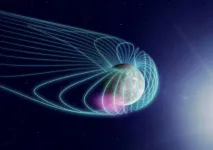(Press-News.org) Discharged in large quantities by textile, cosmetic, ink, paper and other manufacturers, dyes carry high-toxicity and can bring potential carcinogens to wastewater. It’s a major concern for wastewater treatment—but researchers in Drexel University’s College of Engineering may have found a solution, using a tiny nanofilament.
A study lead Michel Barsoum, Ph.D., Distinguished University professor in the College of Engineering, and his team, including researchers from Drexel’s College of Arts and Sciences, found that a one-dimensional, lepidocrocite structured titanium oxide photocatalyst material has the ability to break down two common dye pollutants — rhodamine 6G and crystal violet — under the visible light spectrum. The material also reduced those dye concentrations in the water by 90% and 64%, respectively, in just 30 minutes, when the starting catalyst to dye mass ratio was 1 to 1.
“This is an exciting finding because it helps to address a problem that has been a real challenge for the water treatment process,” Barsoum said. “We anticipate that integrating our titanium-oxide photocatalyst into the current processes could improve its effectiveness in removing these chemicals, as well as reducing the amount of energy required to do so.”
The process starts with adsorption, where the dye adheres to the surface of the nanofilament, and once illuminated undergoes photocatalysis. The dye sensitizes the nanofilaments to visible light. This process accelerates degradation, allowing the dye to break apart into harmless byproducts such as carbon dioxide and water.
The study, recently published in the journal Matter, found that the key to the dye degradation and self-sensitization process was the ability of the material to generate electron holes and something called “ROS” — hydroxyl , superoxide and singlet oxygen, radicals, as well as electron “holes.”
The two dye targets are commonly appearing dye driven effluents in wastewater. Effluent, which literally means something that flows out, is different than sewage found in wastewater. Solid waste can be filtered, removed before the water is purified. Effluent is suspended in the water, making it hard to separate and remove.
Rhodamine 6G is a xanthene-derived dye primarily used in wood processing, paper dyeing, pen ink and cosmetics. Crystal violet, a triphenylmethane dye, is used to dye ink and textiles. These dyes are water soluble and any excess is discharged as effluent.
Wastewater is a major environmental concern worldwide and its existence has long-term impacts on health of humans, aquatic plants and animals. Households and industry generate nearly 380 billion cubic tons of wastewater globally each year. Only 24% of this is treated sufficiently due to challenges in treatment, including high energy consumption, the existence of residual chemicals, treatment center staffing and the insufficient processing of complex and persistent contaminants, including dyes.
The most common wastewater treatment methods, such as sedimentation, biological oxidation and chemical-physical treatment, are ineffective at removing dyes, according to the researchers, due to the dyes’ complex molecular structure and water-soluble nature.
Adsorption with clay materials, activated carbon, iron oxide and natural materials such as coffee grounds, has also been used before and exhibit high cationic dye uptake, exchanging ions or forming bonds. However, these materials simply allow separation of the dye from the water — the dye still exists and is simply attached to the adsorbent materials within the wastewater.
Photocatalysts, long thought to be the key to removing dyes from water, thus far have not produced a sustainable solution. According to Barsoum, many photocatalysts typically require UV light treatment, which uses extensive energy. The impact of the new nanofilament resides in its self-sensitization behavior, which makes the nanofilament more sensitive to visible light.
“The use of visible light - light the human eye can see - like the sun or other simulated light sources, could significantly reduce the financial and energy consumption costs associated with treatment, while still being highly effective at removing dyes from wastewater, eliminating the toxic effluents,” said Adam Walter, a doctoral student in Barsoum’s research group, and the first author on the paper, in the Department of Materials Science and Engineering. “This also presents an exciting opportunity for expansion into other fields like solar cells or optical devices.”
The result: cleaner water without the use of additional toxins or additional energy.
To perform the study, the team used x-ray diffraction to characterize the arrangement of atoms in the nanomaterial. They further characterized the nanomaterial with scanning and transmission electron microscopy, which sends beams of electrons at the material to form an image.
To monitor dye decolorization, the team monitored the sample using ultraviolent-visible spectroscopy and quantified mineralization by chemical oxygen demand. The study details the structural and optical properties of the nanofilaments, as well as the promise of the material for wastewater treatment due to its adsorption efficiency of both dyes tested in the study.
One of the most important findings of the study was the strong evidence that the nanofilament is sensitized by the dye, representing a symbiotic relationship of additive and effluent that resulted in cleaner, less toxic water. One way of thinking about this, Walter said, is that the dye catalyzes in its own destruction.
In addition, while this study showed proof that the nanofilament could be leveraged to improve water treatment capability, it also serves as first proof that the materials can be sensitized, opening the door to other applications in solar cells and optical devices. Earlier this year, the same nanofilament was studied by the team and found to harness sunlight for hydrogen separation, which could unlock its potential in green fuel generation.
“We are just beginning to uncover the possibilities of this material,” Barsoum said. “As we better understand the processes enabling its behavior, we anticipate exploring new applications where it could improve the performance of technology that the world needs to move toward a more sustainable future.”
END
Titanium oxide material can remove toxic dyes from wastewater
Drexel University researchers show titanium oxide material's potential for water treatment
2023-10-10
ELSE PRESS RELEASES FROM THIS DATE:
Role of methylation in vernalization and photoperiod pathway: a potential flowering regulator?
2023-10-10
Recognized as a pivotal developmental transition, flowering marks the continuation of a plant's lifecycle. Flowering time determines the length of plant reproductive period and environmental adaptability. The correct flowering time is very significant for plants to reproduce fruit successfully and is controlled by environment and endogenous signals. Vernalization and photoperiod are the two main flowering pathways orchestrating a large number of floral signals. Methylation is one of the most important epigenetic modifications, which is involved in many key plant growth and development events. Methylation, including histone methylation, DNA methylation ...
Wireless, battery-free electronic ‘stickers’ gauge forces between touching objects
2023-10-10
Engineers at the University of California San Diego have developed electronic “stickers” that measure the force exerted by one object upon another. The force stickers are wireless, run without batteries and fit in tight spaces. That makes them versatile for a wide range of applications, from arming robots with a sense of touch to elevating the immersive experience of VR and AR, making biomedical devices smarter, monitoring the safety of industrial equipment, and improving the accuracy and efficiency of inventory management in warehouses.
They could be used, for example, in knee implants to measure the forces that implants exert on the joint. ...
How to cope when your values clash with your co-workers’
2023-10-10
COLUMBUS, Ohio – In our increasingly polarized society, more people may find themselves in a workplace where they are one of the few conservatives or few liberals around.
A new study found that those whose values – political or otherwise – don’t match the majority in their organization felt they received less respect and as a result were less engaged at work. Moreover, their co-workers noticed their lack of engagement.
“It is a real issue that organizations face,” said Tracy Dumas, lead author of the study and associate professor of management and human resources at The Ohio State University’s ...
Source of electron acceleration and X-ray aurora of Mercury ̶ local chorus waves detected
2023-10-10
Background
Since Mercury is the closest planet to the Sun among the solar system planets, it is strongly influenced by the solar wind, a high-speed (several hundred km/s) stream of plasma blowing from the Sun. Explorations of Mercury was first carried out by the Mariner 10 spacecraft in 1974 and 1975, which revealed that Mercury has a magnetic field, and thus a magnetosphere, similar to that of Earth. In the 2000s, the MESSENGER spacecraft provided a detailed picture of the Mercury's magnetic field and magnetosphere, and revealed that Mercury's magnetic field center is shifted northward from the planet’s center by approximately ...
NIH provides $1.2 million for ambitious effort to battle antibiotic resistance
2023-10-10
University of Virginia researchers are working to outrace two dangerous germs known for quickly developing resistance to new antibiotics – and the scientists’ efforts could help us better combat antibiotic resistance more broadly.
A team led by Jason Papin, PhD, is developing sophisticated computer models of Staphylococcus aureus and Pseudomonas aeruginosa, two multi-drug resistant bacteria that infect thousands of Americans every year. The researchers will use their models to better understand the cellular processes and gene activity that make the bacteria ...
Researchers test large language model that preserves patient privacy
2023-10-10
OAK BROOK, Ill. – Locally run large language models (LLMs) may be a feasible option for extracting data from text-based radiology reports while preserving patient privacy, according to a new study from the National Institutes of Health Clinical Center (NIH CC) published in Radiology, a journal of the Radiological Society of North America (RSNA). LLMs are deep-learning models trained to understand and generate text in a human-like way.
Recently released LLM models such as ChatGPT and GPT-4 have garnered attention. However, they are not compatible with healthcare data due to privacy constraints.
“ChatGPT and GPT-4 are proprietary models that require the user ...
DNA aptamer finds novel application in regulating cell differentiation
2023-10-10
Generating specific cell lineages from induced pluripotent stem cells and embryonic stem cells is the holy grail of regenerative medicine. Guiding iPSCs toward a target cell line has garnered much attention, but the process remains challenging. Now, researchers from Japan have discovered that an anti-nucleolin DNA aptamer, iSN04, can determine a cell’s lineage during differentiation. By demonstrating the generation of cardiomyocytes from murine pluripotent stem cells, their concept shows promise as a regenerative therapy.
Self-renewal ...
Monitoring African copper and cobalt mining emissions from space
2023-10-10
Emissions associated with mining operations in Africa’s Copperbelt can be quantified from space, according to new research led by the National Center for Atmospheric Research (NCAR).
Mining for copper and cobalt in Africa has rapidly increased, the latter in response to growing global demand for electric vehicles, laptops, smartphones, and other devices that rely on lithium-ion batteries, the vast majority of which contain cobalt.
The new study is published in Geophysical Research Letters, ...
Study compares health information exchange data versus patient self-reports to measure cancer screening uptake
2023-10-10
INDIANAPOLIS – Knowing which populations are following cancer screening guidelines is important to public health officials and policy makers as well as researchers developing strategies to improve adherence. A recent study is one of the first to compare using health information exchange (HIE) data with patient self-reported data as a means of gathering this intelligence.
The researchers found that completeness of information differed by data source and screening test. HIE data provided more information than patient self-reports about ...
Seamlessly multiplexing memory storage and recall
2023-10-10
Every day we store memories, some of which we are able to recall later. But while we do so, do we keep on storing? Yes! We cannot afford to stop memory formation while we are retrieving prior ones. Imagine, for instance, that you are navigating the city while recalling last night’s events to a friend tagging along. Your brain must memorize aspects of the route even while you are in the story, so that you can find your way back later or reach your next destination.
We seem to perform this task without much conscious effort. Big deal, one could say, as we know that the brain has trillions of synaptic connections, so parallel processing ...
LAST 30 PRESS RELEASES:
Tracing the quick synthesis of an industrially important catalyst
New software sheds light on cancer’s hidden genetic networks
UT Health San Antonio awarded $3 million in CPRIT grants to bolster cancer research and prevention efforts in South Texas
Third symposium spotlights global challenge of new contaminants in China’s fight against pollution
From straw to soil harmony: International team reveals how biochar supercharges carbon-smart farming
Myeloma: How AI is redrawing the map of cancer care
Manhattan E. Charurat, Ph.D., MHS invested as the Homer and Martha Gudelsky Distinguished Professor in Medicine at the University of Maryland School of Medicine
Insilico Medicine’s Pharma.AI Q4 Winter Launch Recap: Revolutionizing drug discovery with cutting-edge AI innovations, accelerating the path to pharmaceutical superintelligence
Nanoplastics have diet-dependent impacts on digestive system health
Brain neuron death occurs throughout life and increases with age, a natural human protein drug may halt neuron death in Alzheimer’s disease
SPIE and CLP announce the recipients of the 2025 Advanced Photonics Young Innovator Award
Lessons from the Caldor Fire’s Christmas Valley ‘Miracle’
Ant societies rose by trading individual protection for collective power
Research reveals how ancient viral DNA shapes early embryonic development
A molecular gatekeeper that controls protein synthesis
New ‘cloaking device’ concept to shield sensitive tech from magnetic fields
Researchers show impact of mountain building and climate change on alpine biodiversity
Study models the transition from Neanderthals to modern humans in Europe
University of Phoenix College of Doctoral Studies releases white paper on AI-driven skilling to reduce burnout and restore worker autonomy
AIs fail at the game of visual “telephone”
The levers for a sustainable food system
Potential changes in US homelessness by ending federal support for housing first programs
Vulnerability of large language models to prompt injection when providing medical advice
Researchers develop new system for high-energy-density, long-life, multi-electron transfer bromine-based flow batteries
Ending federal support for housing first programs could increase U.S. homelessness by 5% in one year, new JAMA study finds
New research uncovers molecular ‘safety switch’ shielding cancers from immune attack
Bacteria resisting viral infection can still sink carbon to ocean floor
Younger biological age may increase depression risk in older women during COVID-19
Bharat Innovates 2026 National Basecamp Showcases India’s Most Promising Deep-Tech Ventures
Here’s what determines whether your income level rises or falls
[Press-News.org] Titanium oxide material can remove toxic dyes from wastewaterDrexel University researchers show titanium oxide material's potential for water treatment





